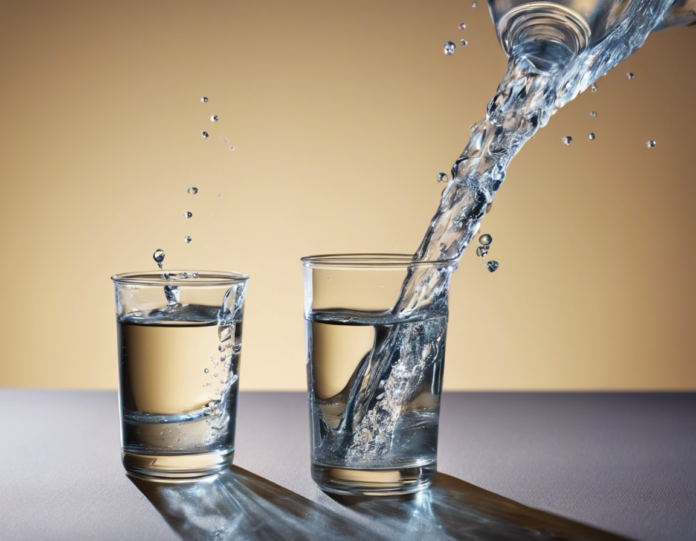Water is a fascinating substance that plays a pivotal role in sustaining life on Earth. One of the unique properties of water is its ability to remain in a liquid state at room temperature, unlike many other substances that may exist as solids or gases at similar conditions. This phenomenon is a result of the intricate interplay between the molecular structure of water and the forces that hold its molecules together.
Water Molecules and Intermolecular Forces
At the heart of water’s liquid state at room temperature are its molecules, each composed of two hydrogen atoms bonded to a single oxygen atom (H2O). These molecules are polar, meaning they possess a slight positive charge on the hydrogen side and a slight negative charge on the oxygen side. This polarity gives rise to hydrogen bonding, a special type of intermolecular force that occurs between the positively charged hydrogen of one water molecule and the negatively charged oxygen of another.
Hydrogen Bonding and Water’s Unique Properties
Hydrogen bonding is a relatively strong intermolecular force that allows water molecules to attract and interact with each other, forming a network of hydrogen bonds throughout the liquid. These hydrogen bonds are dynamic, constantly forming and breaking as water molecules move and collide. It is this network of hydrogen bonds that gives water its unique properties, such as high surface tension, cohesion, and adhesion.
Why Water Is a Liquid at Room Temperature
The presence of hydrogen bonding in water is crucial for understanding why it remains a liquid at room temperature. When water is cooled, the kinetic energy of its molecules decreases, causing them to move more slowly and come closer together. At around 0 degrees Celsius (32 degrees Fahrenheit), water reaches its maximum density before freezing, as the hydrogen bonds hold the molecules in a specific arrangement that allows them to be close but still move past each other. This arrangement prevents the molecules from locking into a fixed crystalline structure, characteristic of solids.
Temperature and Kinetic Energy
At room temperature (around 20-25 degrees Celsius or 68-77 degrees Fahrenheit), water molecules have enough kinetic energy to overcome the attractive forces of hydrogen bonding and move past each other freely, giving water its characteristic fluidity. While some hydrogen bonds persist at room temperature, the thermal energy in the environment continually agitates the molecules, allowing them to break and reform bonds rapidly.
Comparison with Other Substances
In contrast to water, substances that exist as solids at room temperature typically have stronger intermolecular forces holding their molecules together, requiring more energy input to overcome these forces and transition to a liquid state. For example, the melting points of many metals are well above room temperature due to the metallic bonds holding their atoms in a rigid crystal lattice.
Conclusion
In conclusion, the unique structure of water molecules and the presence of hydrogen bonding are fundamental to why water remains a liquid at room temperature. The dynamic nature of hydrogen bonds allows water to flow and adapt to its surroundings, making it essential for various biological processes and environmental phenomena. Understanding the behavior of water at different temperatures enhances our appreciation of its significance in the natural world and underscores its role as a universal solvent and medium for life.
Frequently Asked Questions (FAQs)
-
Why does water have a higher boiling point than other substances with similar molecular weights?
Water’s high boiling point can be attributed to its extensive hydrogen bonding, which requires significant energy input to break the bonds between water molecules and transition from a liquid to a gas state. -
How does water’s density change with temperature?
Water exhibits a unique density profile, reaching its maximum density at around 4 degrees Celsius (39.2 degrees Fahrenheit). As water cools below this temperature, it becomes less dense, which is why ice floats on liquid water. -
Can water exist in a supercooled state below its freezing point?
Yes, water can remain in a liquid state below its freezing point under certain conditions, a phenomenon known as supercooling. Distilled water and pure water are more prone to supercooling than water containing impurities. -
What role do hydrogen bonds play in the high specific heat capacity of water?
Hydrogen bonds contribute to water’s high specific heat capacity, the amount of energy required to raise the temperature of a substance. The breaking of hydrogen bonds absorbs heat energy, leading to water’s ability to moderate temperature changes in the environment. -
How does water’s surface tension affect its behavior in different environments?
Water’s surface tension, a result of the cohesive forces between its molecules, allows insects to walk on water and water droplets to form spherical shapes. This property also contributes to capillary action in plants and the movement of water in soil. -
Why does water have a higher heat of vaporization compared to other liquids?
Water’s high heat of vaporization is due to the energy required to break the hydrogen bonds between water molecules during the transition from a liquid to a gas. This property makes water efficient at dissipating heat and vital for maintaining temperature balance in living organisms. -
How does the presence of impurities affect the freezing and boiling points of water?
Impurities in water disrupt the formation of hydrogen bonds between water molecules, leading to a decrease in both the freezing point (freezing point depression) and the boiling point (boiling point elevation) of the water. This is the principle behind antifreeze additives in car radiators. -
What is the role of water as a solvent in biological systems?
Water’s polarity and ability to form hydrogen bonds make it an excellent solvent for polar and ionic compounds in biological systems. Water facilitates the dissolution, transport, and chemical reactions of biomolecules, playing a crucial role in metabolic processes and cell functions. -
How does the pH of water affect its properties and interactions with other substances?
The pH of water, determined by the concentration of hydrogen ions (H+) and hydroxide ions (OH-), influences its acidity or basicity. Changes in pH can alter the structure and function of biomolecules, affect nutrient availability in soil, and impact aquatic ecosystems. -
What are some practical applications of water’s unique properties in everyday life?
Water’s unique properties, such as high surface tension, capillary action, and heat capacity, find practical applications in various fields. Examples include the use of water as a coolant in engines, the capillary rise of water in plants, and the cleaning action of water due to its ability to dissolve various substances.






